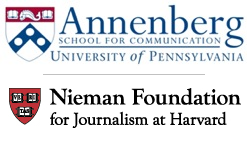 [Today we’re beginning a series of essays here at the Lab dealing with an important set of players in contemporary journalism: non-governmental organizations, or NGOs. Its title: “NGOs and the News: Exploring a Changing Communication Landscape.” Our friends at Penn’s Center for Global Communication Studies explain below. —Josh]
[Today we’re beginning a series of essays here at the Lab dealing with an important set of players in contemporary journalism: non-governmental organizations, or NGOs. Its title: “NGOs and the News: Exploring a Changing Communication Landscape.” Our friends at Penn’s Center for Global Communication Studies explain below. —Josh]
The past decade has seen dramatic changes in the information and communication environment. Parameters as to who has access to information gathering and dissemination have altered rapidly and irreversibly. Civil society actors such as NGOs and advocacy networks are becoming increasingly significant players as the traditional news media model is threatened by shrinking audiences, the availability of free content online, and the declining fortunes of mainstream media. To what extent do NGOs take on functions as information intermediaries, working in cooperation with, or even in the stead of, traditional news organizations? Are we witnessing a general trend, or do NGOs fulfill specific purposes in times of crisis or critical events that focus attention on a specific (international) topic? And what are the consequences of this for the fields of advocacy and journalism?
This essay series, organized by the Center for Global Communication Studies (CGCS) at the Annenberg School, University of Pennsylvania, in cooperation with the Nieman Journalism Lab at Harvard University, seeks to examine these critical questions from a variety of perspectives, and encourage discussion and deliberation on what these changes mean for NGOs, traditional media outlets, news consumers, and society as a whole. Each week, for the next three months, we will feature a new essay on the subject. These essays are the outcome of recent workshops that have explored various aspects of these developments.
NGOs as a supplement — or replacement?
One field of inquiry addresses the question of how NGO communication practices have changed over time. NGOs are, not surprisingly, adapting to — and to some extent taking advantage of — the changing information and communication environment. They are becoming increasingly involved in the gathering and delivery of international news, using a range of communication channels and technologies. In some cases, NGOs may form partnerships with mainstream media outlets. In others, NGOs act as their own news agencies, developing into their own media hubs or speaking to audiences and constituencies in a direct and unmoderated fashion.
There is also the broadening range of communication strategies employed by NGOs. How do different NGOs maneuver in today’s growing, but also increasingly crowded information spaces? An NGO’s size, mission, and resources influence how the organization thinks about, uses, and disseminates information. Traditional or so-called “legacy” NGOs must adapt to the new opportunities, negotiating and coexisting with new media and network-based NGOs such as Ushahidi or the Hub, for whom the current information ecology is a raison d’être.
New technologies and social networking platforms such as Twitter and Facebook, as well as more traditional media partnerships, offer NGOs a number of avenues, both old and new, for disseminating information. As advocacy organizations become more active in gathering and disseminating news, this raises a number of consequences, challenges, and ethical dilemmas. NGOs have their own agendas, and have not traditionally been expected to hew to the journalistic standard of objectivity. As they move into this arena, what consequences does this indicate for journalistic standards of objectivity and verification? And what repercussions does this shift have for NGOs’ communication strategies, branding efforts, and organizational integrity and credibility? These challenges are further exacerbated by the growing competition that NGOs face in the news space from bloggers and citizen journalists, among others, who also fill information spaces and develop news making capacity of their own.
An evolution of standards?
Finally, these developments have a significant impact on the traditional news makers: news media outlets, journalists, and editors. What happens when news making and journalistic functions are increasingly outsourced or claimed by other actors with no original training in this field and its editorial standards? How central are new media to the alterations and growing distortions of the traditional journalistic sphere and how, if at all, can they be harnessed?
The essays serve several aims. They speak directly to a community of practice consisting of NGO experts, journalists, and academics involved in this field of inquiry. They list and share best practices, suggestions, and warnings. And they map a new landscape of communication processes, which holds conceptual and methodological challenges for academic inquiry and research. The series is intended to inspire and encourage ongoing discussion among practitioners and researchers. We hope you will join us and contribute to a vivid and fruitful exchange.
Monroe Price is director of the Center for Global Communication Studies at the Annenberg School for Communication, University of Pennsylvania and professor at the Cardozo School of Law, Yeshiva University. Libby Morgan is senior research coordinator at the Center for Global Communication Studies. Kristina Klinkforth is a research fellow and PhD candidate with Freie Universität Berlin who recently completed an academic research year at the School of Media and Public Affairs, George Washington University.